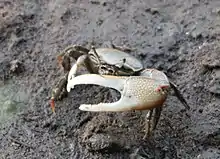Minuca minax
Minuca minax, commonly known as the red‐jointed fiddler crab or brackish-water fiddler crab,[1] is a species of fiddler crab that is found in the United States from Massachusetts to the Gulf of Mexico. It is one of the most common macroinvertebrates in salt marshes in these states.[2] It prefers areas of lower salinity than other fiddler crabs,[3] and can be found in great numbers along the banks of tidal streams, even at distances greater than 50 km (31 mi) from the sea.[4]
| Minuca minax | |
|---|---|
 | |
| Scientific classification | |
| Domain: | Eukaryota |
| Kingdom: | Animalia |
| Phylum: | Arthropoda |
| Class: | Malacostraca |
| Order: | Decapoda |
| Suborder: | Pleocyemata |
| Infraorder: | Brachyura |
| Family: | Ocypodidae |
| Subfamily: | Gelasiminae |
| Tribe: | Minucini |
| Genus: | Minuca |
| Species: | M. minax |
| Binomial name | |
| Minuca minax (Le Conte, 1855) | |
Minuca minax was formerly in the genus Uca, but in 2016 it was placed in the genus Minuca, a former subgenus of Uca.[5][6][7]
Description
Like other fiddler crabs, Minuca minax males have one claw that is significantly larger than the other, while females have two equal-sized smaller claws. The joints on the claws are red, a noticeable feature that is the origin of the common name "red‐jointed fiddler crab".
Reproduction
Minuca minax breed for two weeks in the summer in a small round burrow dug by the male. The larvae are unable to survive in the lower-salinity brackish water preferred by adults, and the adults do not travel to the sea to release the larvae. As such, the larvae use ebb tides to travel to higher-salinity environments to develop before returning as adults.[4]
References
- Palmer, John D. (1989-04-01). "Comparative studies of tidal rhythms. VII. The circalunidian locomotor rhythm of the brackish‐water fiddler crab, Uca minax". Marine Behaviour and Physiology. 14 (3): 129–143. doi:10.1080/10236248909378700. ISSN 0091-181X.
- Trott, Thomas J.; Voigt, Rainer; Atema, Jelle (1997-05-01). "Chemoreception by the red‐jointed fiddler crab Uca minax (Le Conte): Spectral tuning properties of the walking legs". Marine and Freshwater Behaviour and Physiology. 30 (4): 239–249. doi:10.1080/10236249709379028. ISSN 1023-6244.
- Miller, Kenneth G.; Maurer, Don (1973-09-01). "Distribution of the Fiddler Crabs, Uca pugnax and Uca minax, in Relation to Salinity in Delaware Rivers". Chesapeake Science. 14 (3): 219–221. doi:10.2307/1350613. ISSN 0009-3262. JSTOR 1350613.
- Brodie, Renae J.; Styles, Richard; Borgianini, Stephen; Godley, Jenice; Butler, Khayree (2007-11-01). "Larval mortality during export to the sea in the fiddler crab Uca minax". Marine Biology. 152 (6): 1283–1291. doi:10.1007/s00227-007-0777-y. ISSN 0025-3162. S2CID 84002603.
- Shih, Hsi-Te; Ng, Peter K. L.; Davie, Peter J. F.; Schubart, Christoph D.; et al. (2016). "Systematics of the family Ocypodidae Rafinesque, 1815 (Crustacea: Brachyura), based on phylogenetic relationships, with a reorganization of subfamily rankings and a review of the taxonomic status of Uca Leach, 1814, sensu lato and its subgenera". The Raffles Bulletin of Zoology. 64.
- Rosenberg, Michael S. (2019). "A fresh look at the biodiversity lexicon for fiddler crabs (Decapoda: Brachyura: Ocypodidae). Part 1: Taxonomy". Journal of Crustacean Biology. 39 (6).
- "WoRMS taxon details, Minuca Minax (Le Conte, 1855)". World Register of Marine Species. Retrieved 2020-11-16.